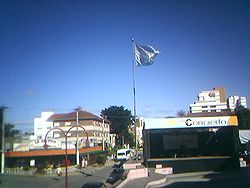Villa Gesell

|
||
| Basic data | ||
|---|---|---|
| Full name: | Villa Silvio Gesell | |
| location | 37 ° 15 ′ S , 56 ° 58 ′ W | |
| Height above d. M .: | 0 m | |
| Population (2001): | 23,257 | |
|
|
||
| administration | ||
| Province : |
|
|
| Partido : | Villa Gesell | |
| Mayor: | Dr Rodríguez Erneta (FPV) | |
| Others | ||
| Postal code : | B7165 | |
| Telephone code: | 02255 | |
| Website of Villa Gesell | ||
Villa Gesell , often just called Gesell , is a seaside resort in Argentina , located in the province of Buenos Aires . The city on the coast of the South Atlantic is the administrative center of the Partidos of the same name and has around 30,000 permanent residents.
Surname
The name translates as Gesell-Stadt and goes back to Silvio Gesell , the father of the city's founder, Carlos Gesell . In use today, however, the abbreviated name Villa Gesell is used .
history
Carlos Gesell, who ran a pram factory in Argentina with his brother Ernesto , learned in 1931 that a ten-kilometer-long and 1,600-meter-wide stretch of coast was for sale north of Mar del Plata . The price was extremely cheap, as shifting dunes and drifting sand shaped the tubular area. Carlos Gesell had recently visited the Belgian seaside resort of Oostende and enthusiastically noticed a certain similarity in the landscape.
As a child and adolescent, through the eventful life of his father Silvio Gesell, he got to know different forms of human coexistence, including a rural commune in Switzerland and the colony of Eden near Oranienburg, which was characterized by vegetarianism and life-reforming ideas . The impulses he received there led to his lifelong dream of realizing an alternative working and living community in Argentina. The coastal strip on the Atlantic seemed to offer him the right conditions for this.
In the spring of 1932, Carlos Gesell began to cultivate the dune landscape against the resistance of his brother. He built a wooden house and tried to plant pine and acacia trees in the dune landscape . A huge sandstorm buried these beginnings.
Gesell sought advice in Germany . An agricultural engineer who had successfully carried out reforestation on the East Frisian Islands advised him. But another attempt at planting also failed. Gesell returned to Germany and fell out with his brother. He had his share of the business paid out and developed a new plan to plant the dunes in the coastal region. He bought beach grass in Germany and first planted it on an experimental field when he returned home. The first successes were achieved. The dune landscape gained stability. He then tried again to plant trees - with success. The shifting dunes were stabilized. This engagement earned Carlos Gesell the nickname Madman of the Dunes .
Between 1936 and 1937 Carlos Gesell employed Timoteo Henckels, the emigrated son of the theater and film actor Paul Henckels, for this work . He had received a two-year training as an agricultural assistant in Germany. Before leaving, he visited the dunes of Sylt to collect grass seeds and get to know the fortification system there. After a year, Timoteo Henckels gave up because he saw no perspective for himself. Nor could he realize his wish to learn Spanish in his lonely planting activity, since he was usually the only worker in the dunes.
The permanent shortage of money forced Gesell to look for new income. He tried breeding pigs and goats - without success. When in 1940 some deep-sea anglers from Buenos Aires accidentally landed on its coast and discovered the enormous abundance of fish there, Gesell developed the idea of opening up his land to tourism. He built a street parallel to the coast, the Bulevar Silvio Gesell , today's main and commercial street Villa Gesells. The first guest house, Pension Sommerschwalbe , was built as early as 1941 . Carlos successfully advertised his paradise of solitude in a newspaper advertisement and named it Villa Silvio Gesell .
The first settlers followed, leasing land and building houses on it. Shops sprang up and a school was founded. Carlos Gesell paid the teacher out of pocket.
In the 1950s, Villa Gesell was connected to the Argentine transport network. Smoking was prohibited in the place. Alcohol was only allowed on holidays and gambling was generally prohibited.
In the 1960s, artists discovered Villa Gesell . Painters, musicians, and photographers shaped the townscape. A pier that extends far out into the sea was built. The city became particularly popular with campers and young people in the 1960s and 1970s, until more and more hotels and entertainment venues were built and mass tourism took hold.
Carlos Gesell, who was awarded the Federal Cross of Merit in 1971 , died in Buenos Aires in 1979 at the age of 88.
Villa Gesell today
Many of Gesell's descendants still live in Villa Gesell today . A granddaughter runs there u. a. a campsite . A museum , located in the first house built by Carlos Gesell, the Casa Gesell , commemorates the city's founder.
Around 750,000 tourists visit the city each season, making it one of the main tourist centers in Argentina .
Web links
- Official Villa Gesell Portal [in Spanish]
- IFAM Population Statistics (Spanish)
- Villa Gesell - Report from the weekly newspaper DIE ZEIT 15/1997
Individual evidence
- ↑ Ulrich Sackstedt: Amigo Timoteo. From the actor's son to the cattle breeder, in: Weites Grünes Land. Stories of emigrants from Argentina (OutdoorHandbuch), Conrad Stein Verlag GmbH, Welver 2006, ISBN 978-3-86686-193-0
